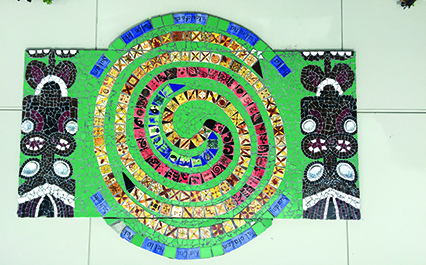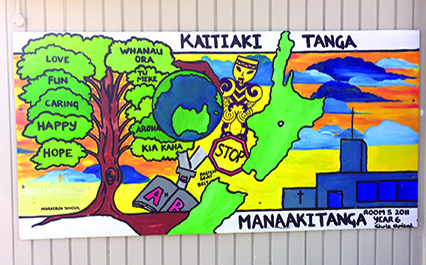Page Content
Thomas Midbo (back left), president of the Alberta Teachers’ Association Council for School Leadership, visits Russell School outside of Wellington, New Zealand along with a group of Alberta teachers last May.
Over the next three years, schools in Alberta and New Zealand will explore strategies to address equity in mathematics. One of key thrusts of these communities of mathematical inquiry will be to explore the work of Dr. Bobbie Hunter, a researcher, academic and New Zealand-born Cook Islander, whose focus is on better meeting the needs of all students and of Pasifika learners in particular.

Student art is the core of the community at Russell School where Māori and Pasifika families shape the culture of the school.
Cultural Exchange
My school community, New Norway School, has been included in a three-year international partnership between three Alberta schools and three New Zealand schools.
During part one of what will be a three-round visitation cycle with New Zealand, I observed three different school programs. These visits strengthened my belief in the value of international partnerships.
The approach taken by the participating New Zealand schools teaching “maths” includes a deep integration of cultural components. All three schools provide strong evidence that a student’s level of engagement increases significantly when the student has a personal and community connection to the material. For example, during the delivery of several lessons there were many cultural components from their indigenous peoples, including Mori, Samoan and Pasifika. The cultural components were completely interwoven in the mathematical questions/problems used as well as in the reinforcement portion of the lessons. These strategies all resonate with the goal of the partnership to advance equity in mathematics learning.
This international partnership is a very effective way for a professional to analyze and reflect on their own programs/practices at a deeper level. Professionals are provided the opportunity to observe, ask questions and develop an understanding of the pedagogy behind the instructional approaches used by a different school system.
Through this partnership, our professionals were also fortunate to be able to explain our practices, which resulted in an exchange of different cultural paradigms. Describing and explaining our professional practice to foreign colleagues was a powerful experience.
I am greatly looking forward to my continued involvement in the Alberta/New Zealand project as we strengthen our collaborative learning though the next phase of the partnership cycle when our colleagues from New Zealand return this October.
—Thomas Midbo, principal, New Norway School; president, Alberta Teachers’ Association Council for School Leadership
Leading Across For Equity In Mathematics
“Given a culturally diverse student population, how do we ensure active engagement of each student’s pursuit of mathematics mastery?”
This is the research question we are pursuing in our work with New Zealand primary schools. Although the schools we visited were “decile one” schools, identified as having low socio-economic status, it was apparent that the students felt cared about, were trying their best and appeared to be happy and enjoy school. It did not matter if they were Maori, Samoan, Pasifika or Cook Island by heritage — they all belonged.
Here at Acadia School in Calgary, we have students from families from around the world — there are 44 heritage languages spoken other than English. Like our school, the New Zealand schools were very purposeful in incorporating cultural language and references into conversation, instruction and teaching. The mathematical problems reflected the students’ varied cultural backgrounds; students could see the math problems as being useful and applicable in their daily lives.
As we look back on our initial experience in the three schools we visited, we are motivated even more to develop a plan for incorporating First Nations culture into student work in ways that would be intentional and based on solid research. In this way we might, as we move forward, better understand how the New Zealand teachers move fluidly through language and culture.
Given the uneven playing field that exists for many English language learners in both Alberta and New Zealand schools, students with special needs, children experiencing trauma or relentless poverty, and students of colour who confront conscious or unconscious biases about their capacity to learn, this partnership makes us appreciate even more that we need to find those meaningful entry points and real-life connections for success in mathematics.
—Barb James, principal; Dawn Poole, learning leader; Acadia School, Calgary

Another example of community art on display at Russell School.
